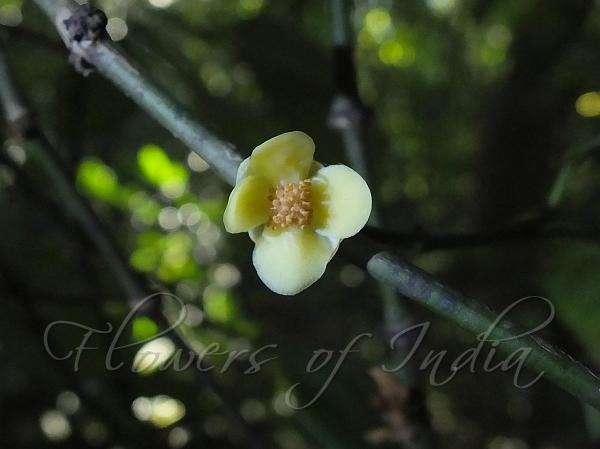|
| Indian Gamboge |
|

|

| File size | 504592 |
| Original date | 11/17/14 11:15 AM |
| Resolution | 2048 x 1536 |
| Flash | Flash did not fire, auto |
| Focal length | 6.1mm |
| Exposure time | 1/640s |
| Aperture | 2.8 |
| Focus Distance | |
| Metering Mode | Spot |
| Camera make | FUJIFILM |
| Camera model | X-S1 |
| Sensor type | OneChipColorArea |
|
|
|
|
Photo: |
Botanical name: Garcinia morella Family: Clusiaceae (Garcinia family)
Synonyms: Garcinia gutta, Garcinia cambogioides
Synonyms: Garcinia gutta, Garcinia cambogioides
Indian Gamboge is an evergreen tree up to 18 m
tall. Bark is smooth, dark brown; blaze white. Branchlets are angular,
hairless, latex bright yellow, profuse. Leaves are simple, opposite,
clustered at branch ends; leaf-stalk 0.6-1.5 cm long, channeled,
sheathing at base, hairless. Leaf blade is 6.5-15 x 3.5-8 cm, usually
elliptic, sometimes narrow obovate, tip pointed to tapering, base
narrowed; leathery or subleathery, hairless; secondary nerves 6-8
pairs; tertiary nerves obscure. Flowers are polygamodioecious, reddish,
stalkless; male flowers are 2-4 in in leaf-axils fascicles or on old
wood; sepals 4 round, decussate, outer pairs smaller than the inner,
hairless; petals 4, little larger than sepals, round, veined, concave;
stamens 10-12, monadelphous, the filaments combined in to a
subquadrangular central column, anthers red, round; female flowers are
borne in leaf-axils, solitary, larger than male flowers. Berry is 3 cm
across, 4-seeded. Indian Gamboge is found in Indomalaysia; in the
Western Ghats- throughout South and Central Sahyadris. Flowering:
February-April.
| Identification credit: Siddarth Machado | Photographed in Sakleshpur, Karnataka. |
• Is this flower misidentified? If yes,